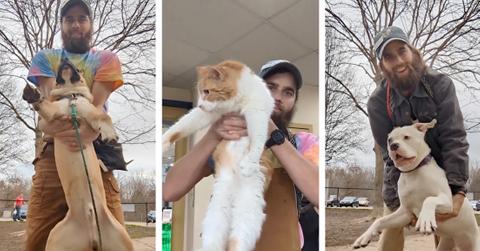The Viral "Dangle Test" Is Helping Shelter Animals Get Adopted — but Is It Ethical?
Published Jan. 2 2024, 3:51 p.m. ET
Cameron Shoppach is on a mission to help Indiana shelter IndyHumane's adoptable animals (and shelter animals all around the U.S.) find forever homes. His method — a "dangle test" which involves dangling a cat or dog his arms to determine the animal's temperament and amenability to being held — is unconventional, but the self-appointed Dangler in Chief has taken the internet by storm and provided a much-needed boon to the "adopt, don't shop" movement.
Shoppach's rudimentary test isn't his own creation; as recently as July 2022, a veterinarian went viral for the same temperament-taking test involving wiggly, adorable dogs and cats, per Newsweek.
While the fervor over the latest animal industry employee to dangle a cute animal for likes has helped senior and otherwise overlooked shelter animals get adopted, and while the act is still a far cry from heinous dangling-based cases of animal cruelty, we explore the good and the bad, including the potential pitfalls and safety concerns, of this internet trend.

Cameron Shoppach is going viral for the "Does It Dangle?" test for cats and dogs.
Shoppach, an IndyHumane employee whose responsibilities include facilitating play groups at the shelter, has been nicknamed the Dangler in Chief for his viral videos of dogs and cats performing the "Does It Dangle?" test, per People.
In the videos, Shoppach shows himself playing with the adoptable animal before picking them up and dangling them in his arms. The videos feature text overlays asking whether the animal's name will dangle, and either a green checkmark or red X is given depending on how squirmy the animal is and how energetically they attempt to break free.
The informal test, which includes picking up an animal in one's arms and allowing them to loosely dangle and observing whether they remain hanging or attempt to break free, is more frequently utilized to assess the temperament of a cat. Shoppach, however, told USA Today that applying the test to shelter dogs has afforded them a "second chance" opportunity when they otherwise have been overlooked by prospective adopters.
For animals like Tank, one of Shoppach's favorite dogs in the shelter whom Shoppach describes as having a terrible kennel presence, the videos highlight the other, more desirable traits that potential adopters may be seeking, such as playfulness and affection.
And as the comments pour in from adoring followers on TikTok and Instagram, there has also been a growing number of comments asking whether picking up an animal and dangling it for likes is ethical.
Make sure not to dangle your own pets at home.
People notes that Shoppach is a "trained animal rescuer," though his formal education and certifications are unclear. To his credit, Shoppach advises the public not to pick up an animal and perform the dangle test like he does in his videos.
To be clear, Shoppach is just one of a seemingly endless number of social media-savvy users dangling their cats and their dogs for likes. The unfortunate history of the use of animals for human entertainment is a storied one, per Sentient Media, and it's been argued that social media platforms have done a poor job of enforcing the boundary between an adorable companion animal video and an abusive one, according to Counting Stars.
The boundary, though, is rarely black and white.
"I appreciate the overall goal from Cameron and IndyHumane on using these videos to highlight the animals in their shelter who typically get ignored, like Tank," Michelle Bernstein, ACAAB, M.A, feline and animal behaviorist, tells Green Matters. "I can appreciate that the article in People did mention that Cameron advises that the general public doesn’t try dangling animals themselves. Unfortunately, there have been recent popular viral videos and trends involving animals that have put animals in danger and distressing situations."
Acknowledging the comments that question whether his methods are ethical, Shoppach posted a video to both his TikTok and Instagram explaining his intentions, encouraging followers to adopt animals rather than buying them from private breeders, and sharing his gratitude for those who have donated to various causes.
His words are echoed by Bernstein, a trained behaviorist with additional formal graduate education in animal cruelty cases.
"I strongly advise against 'dangling' as it isn’t the proper way to handle any animal and isn't a true testament to their behavior and personality," Bernstein explained. "Just because the animal doesn’t display immediate signs of distress while being dangled doesn’t mean they are comfortable in the situation. I highly recommend learning proper ways to handle every animal and learning how to read every animal’s body language."
For those interested in learning responsible ways to pick up a cat and pick up a dog, the process generally involves monitoring their behavior for signs of distress, ensuring the support of their legs, and being mindful if they wish to break free at a moment's notice.
